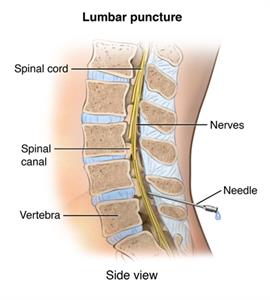Guillain-Barré Syndrome
What is Guillain-Barré syndrome?
Guillain-Barré syndrome (GBS) is also called acute inflammatory demyelinating polyradiculoneuropathy (AIDP). It's a neurological disorder in which the body's immune system attacks the peripheral nervous system. This is the part of the nervous system outside the brain and spinal cord. The onset of GBS can be quite sudden and unexpected. It needs immediate hospitalization. It can develop over a few days. Or it may take up to several weeks with the greatest weakness occurring within the first couple of weeks after symptoms appear.
GBS is rare, affecting about 3,000 people in the U.S. It can affect people at any age and both men and women equally. GBS often develops after a respiratory or gastrointestinal viral infection.
What causes Guillain-Barré syndrome?
It’s not clear why some people get GBS. What is known is that the body's immune system begins to attack the body itself.
Normally, the cells of the immune system attack only foreign material and invading organisms. But in GBS, the immune system starts to destroy the myelin sheath that surrounds the axons of many nerve cells, and sometimes, the axons themselves.
When this occurs, the nerves can’t send signals efficiently, the muscles lose their ability to respond to the commands of the brain, and the brain receives fewer sensory signals from the rest of the body. The result is weakness and an inability to feel heat, pain, and other sensations.
GBS can occur after a viral infection, surgery, injury, or a reaction to an immunization.
What are the symptoms of Guillain-Barré syndrome?
- Tingling and Numbness: A prickly or "pins and needles" feeling (paranesthesia) often starts in the fingers and toes before any muscle weakness appears.
- Muscle Weakness: The weakness usually starts in the legs and spreads upward (ascending muscle paralysis) to the arms. It happens on both sides of the body at the same time.
- Loss of Reflexes: Doctors may check reflexes (like the knee-jerk reflex), and in most people with GBS, these reflexes are missing.
- Pain: Some people feel pain in their limbs or back.
- Breathing Problems: In more severe cases, GBS can make it hard to breathe.
- Facial and Speech Issues: In rare cases, individuals may experience trouble moving their face, swallowing, or speaking.
- Progression: Symptoms get worse over a period of 12 hours to 4 weeks, then usually stop getting worse and stay stable before improving (clinical plateau).
When triggered by an infection, clinical symptoms of GBS usually appear within 3 days to 6 weeks of the infection.
How is Guillain-Barré syndrome diagnosed?
The symptoms of GBS vary. It can be difficult to diagnose in its earliest stages.
These symptoms are unique to GBS:
-
Symptoms on both sides of the body
-
Symptoms appear quickly. They may show up within hours or weeks instead of months.
-
Loss of reflexes
-
High protein level in cerebrospinal fluid (CSF). CSF is the fluid that surrounds the spinal cord and brain.
To diagnose GBS, you may have the following tests:

-
Spinal tap (lumbar puncture). A special needle is placed into the lower back, into the spinal canal. This is the area around the spinal cord. The pressure in the spinal canal and brain can then be measured. A small amount of CSF is removed and sent for testing to find out if there is high protein, an infection, or other problems.
-
Electrodiagnostic tests, such as electromyography (EMG) and nerve conduction velocity (NCV). These studies are done to evaluate and diagnose disorders of the muscles and motor neurons. Electrodes are inserted into the muscle, or placed on the skin overlying a muscle or muscle group. Electrical activity and muscle response are recorded.
How is Guillain-Barré syndrome treated?
There is no known cure for GBS. Without treatment, GBS may get better on its own. But treatment may improve chances of a faster recovery. Treatments, such as plasmapheresis or immunoglobulin, suppress the immune system and reduce inflammation caused by the immune system’s response to the disease. Either of these treatments can reduce the amount of time it takes for you to walk or breathe on your own again.
-
Plasmapheresis is a procedure that removes the plasma (liquid part of the blood) and replaces it with other fluids. Antibodies are also removed with the plasma, which is thought to help reduce the symptoms of the disease.
-
Immunoglobulin is a blood product that helps to decrease the immune system’s attack on the nervous system.
Supportive treatment is also given to prevent breathing problems and relieve symptoms. You will need to stay in the hospital for treatment. Medicines are used to control pain and other conditions that may be present. Physical therapy can increase muscle flexibility and strength. Some people get better in a day or two. Others may take much longer to recover.
Through research, new treatments for GBS are continually being identified.
Key points about Guillain-Barré syndrome
-
Guillain-Barré syndrome (GBS) is a neurological disorder in which the body's immune system attacks part of the peripheral nervous system.
-
The onset can be quite sudden and unexpected. It needs immediate hospitalization.
-
The first symptoms include varying degrees of weakness or tingling sensations in the legs, which sometimes spreads to the arms and upper body.
-
The goal of treatment is to prevent breathing problems and relieve symptoms.
-
Recovery can be lengthy. Residual muscle weakness or paralysis can occur.
Next steps
Tips to help you get the most from a visit to your healthcare provider:
-
Know the reason for your visit and what you want to happen.
-
Before your visit, write down questions you want answered.
-
Bring someone with you to help you ask questions and remember what your provider tells you.
-
At the visit, write down the name of a new diagnosis, and any new medicines, treatments, or tests. Also write down any new instructions your provider gives you.
-
Know why a new medicine or treatment is prescribed, and how it will help you. Also know what the side effects are.
-
Ask if your condition can be treated in other ways.
-
Know why a test or procedure is recommended and what the results could mean.
-
Know what to expect if you do not take the medicine or have the test or procedure.
-
If you have a follow-up appointment, write down the date, time, and purpose for that visit.
-
Know how you can contact your provider if you have questions.






